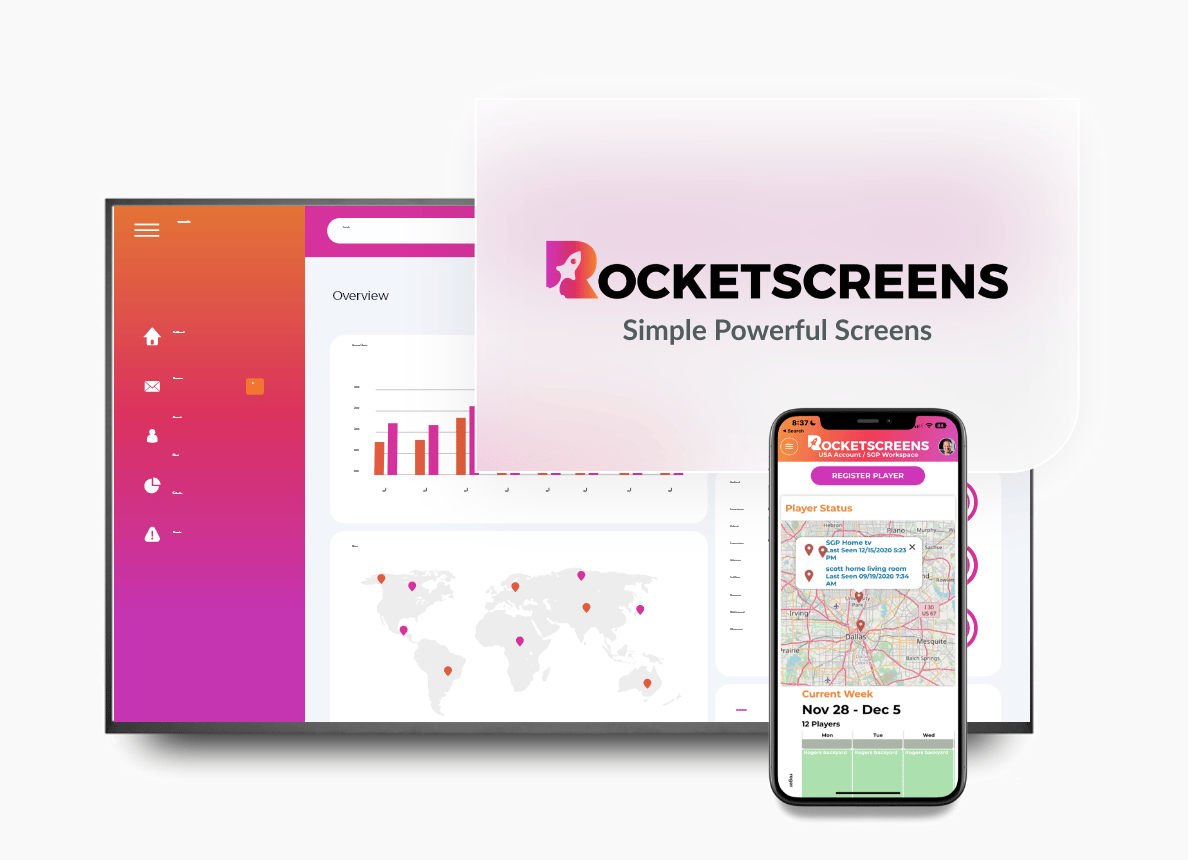
The Future Is Visual: Top Digital Signage Trends for 2026 and Beyond
As 2025 ends, one thing is clear: digital signage has fundamentally changed. It's no longer a "nice-to-have" digital poster. It has evolved into the central, visual communication network for modern business.
This past year, we saw organizations move beyond simple slideshows to broadcasting live, data-driven content. Displaying Power BI dashboards in the sales pit and Salesforce leaderboards in the lobby became the standard, not the exception. Companies finally understood that the true power of a screen is its ability to make data visible and actionable.
But that was just the warm-up.
As we look to 2026, the question is no longer, "Should we use digital signage?" The question is, "How smart, how predictive, and how integrated can our screens become?"
This guide will explore the top digital signage trends for 2026 and show you how to prepare your organization for a future that is more visual, more connected, and more intelligent than ever.
What Is Digital Signage? (A 2026 Refresher)
Before we look forward, let's establish our baseline. In 2026, "digital signage" is not just the hardware (the screens) or the software (the CMS).
Digital signage is the visual layer of your organization's entire tech stack.
It's a platform that securely connects to your most critical data sources — your CRM, your BI tools, your internal communications, and your IoT sensors —and translates that data into engaging, real-time content. It’s the "last mile" of your business intelligence, delivering the correct information to the right people, precisely where they can act on it.
A successful strategy is built on three pillars:
- Hardware: The physical displays. This now includes everything from 8K LED video walls and interactive kiosks to new, power-saving e-paper screens.
- Content: This is no longer just static images. Content is your data. It's your live sales figures, your factory's production numbers, your marketing team's web traffic, your company's social media feed.
- Software (CMS): The most critical piece. This is the central "brain" that connects your content to your hardware. A modern CMS must be simple, scalable, and, most importantly, securely integrated with the tools you already use.
The 5 Biggest Digital Signage Trends for 2026
If 2025 was about showing data, 2026 will be about acting on it.
1. From Real-Time to Predictive: The AI Content Engine
The biggest leap forward will be the integration of predictive AI. Until now, screens have been great at showing what's happening right now. The next evolution is to show what's likely to happen next.
Imagine a screen in a manufacturing plant. Instead of just showing that "Line 3 is down," it can connect to an AI model and display, "Warning: Sensor data on Line 3 shows a 90% probability of failure in the next 4 hours." This transforms the screen from a reporter into a proactive, decision-making tool.
In a retail setting, AI-driven digital menus won't just suggest a cold drink on a hot day. They will analyze inventory, local event schedules, and traffic patterns to promote high-margin items that are most likely to sell at that exact moment.
2. Hyper-Personalization (The "One-to-One" Screen)
We're moving past "one-to-many" broadcasts. Using anonymous video analytics (which detect audience demographics like "group of three," "male, 30s," or "person with a stroller," without identifying anyone personally), screens will tailor content on the fly.
- In an office lobby: A screen might show a building directory by default. When it detects a large group, it might automatically switch to a "Welcome" message for a scheduled company visit.
- In a store: A screen near the athletic wear section can show men's running shoes when a man approaches and switch to women's yoga apparel when a woman stops to look.
This makes the content dramatically more relevant, increasing engagement and sales.
3. Deeper, More Secure Data Integration
As screens become business-critical, security and integration are paramount. Companies cannot risk having sensitive financial data or customer information compromised.
In 2026, the demand for secure, authenticated, and simple integration will be the number one factor in choosing a platform. This is the entire philosophy behind RocketScreens.
Our platform was built to solve this exact problem. We provide a simple, secure bridge to over 100 applications. You don't need to be a developer or an IT expert. You can securely authenticate your accounts in minutes and start streaming:
- Business Intelligence: Live, interactive dashboards from Power BI, Tableau, and Google Data Studio.
- Sales & Marketing: Real-time leaderboards from Salesforce, campaign metrics from HubSpot, or social feeds from LinkedIn and Instagram.
- Internal Comms: Company news from SharePoint, presentations from Google Slides, or channel messages from Slack and Microsoft Teams.
In 2026, if your digital signage platform can't securely connect to your data, it's already obsolete.
4. Sustainability and "Green Signage"
The environmental and financial cost of running thousands of high-brightness screens 24/7 is a serious concern. 2026 will see a major push for sustainable solutions.
The biggest player here is full-color e-paper technology. These displays look like high-resolution printed paper and consume almost no energy unless the content is actively changing.
You won't use this for full-motion video, but it's the perfect solution for:
- Meeting room schedules
- Restaurant menus
- Public transport timetables
- Door signs and wayfinding
This allows organizations to deploy screens in thousands of new locations without worrying about power consumption or a high carbon footprint.
5. Seamless "Phygital" (Physical + Digital) Experiences
The line between the digital world on your phone and the physical world around you will continue to blur. Screens are the bridge.
Instead of just showing a product, a screen will invite interaction.
- QR Codes 2.0: A QR code on a screen won't just take you to a website. It will launch an augmented reality (AR) "try-on" of the product, add an item directly to your mobile cart, or provide a personalized, interactive map to your next location.
- NFC and IoT: Tapping your phone (NFC) on a screen or shelf-edge display could "clip" a digital coupon. In a hotel, a screen will act as a virtual concierge, allowing you to book spa appointments or order room service right from the kiosk.
How to Prepare Your Digital Signage Strategy for 2026
The technology is exciting, but it's useless without a clear strategy. Here’s how to get ready.
1. Start with Your "Why" (And Your Data)
Don't start by buying a screen. Start by identifying your problem or goal.
- Problem: "Our sales team isn't aligned on their monthly quota."
- Solution: A screen in their area displaying a live Salesforce dashboard.
- Problem: "Our factory floor isn't hitting its safety targets."
- Solution: Screens in break rooms and on the line showing real-time safety stats and reminders.
- Problem: "Our lobby feels dated and uninviting."
- Solution: A modern welcome screen showing a social media feed, company news, and a welcome message for visitors.
Your goal will tell you what data you need to show.
2. Choose Your Platform First, Hardware Second
This is the most common mistake organizations make. They buy a "smart TV" and then try to figure out how to get their content on it.
Your Content Management System (CMS) is the single most important decision you will make. It is the engine. The screen is just the windshield.
When evaluating a platform, ask these questions:
- Is it simple? Can my marketing or HR team use it, or does it require an IT specialist?
- Is it secure? How does it connect to my sensitive data? Does it use secure authentication?
- Is it integrated? Does it have a large library of pre-built connections to the apps I already use (like Power BI, HubSpot, Slack, etc.)?
- Is it scalable? Can I manage one screen in my lobby and 500 screens across the globe from the same, simple interface?
3. Think in "Channels," Not "Slides"
Your digital signage is not a PowerPoint presentation. It's a TV network.
You should create "channels" for different audiences, locations, and times of day.
- The "Lobby Channel": Plays from 8 AM - 5 PM. Content includes welcome messages, company brand videos, and a live news/weather feed.
- The "Sales Floor Channel": Shows the Salesforce leaderboard, motivational quotes, and new-client-win announcements.
- The "Break Room Channel": Plays during lunch hours. Shows company culture photos, HR announcements for benefits, and a "fun" feed like an Instagram or YouTube channel.
This approach ensures the content is always relevant to the audience watching it.
The Future Is Connected. Your Screens Should Be Too.
As 2025 comes to an end, the path forward is clear. The future of communication is visual, data-driven, and automated. The static posters in your hallways and the outdated memos in your breakroom are no longer just inefficient; they are a missed opportunity.
Your organization's most valuable information, your sales goals, your production metrics, your company culture—is already there, in the digital tools you use every day.
The challenge for 2026 is to unlock that data and put it where it matters most.
This is exactly why RocketScreens was built. We make it simple for any organization to securely connect to over 100 applications and turn their real-time data into powerful, automated content. No coding, no complex IT projects. Just a simple, secure, and smart platform that grows with you.
Don't let your most powerful information stay locked away in a spreadsheet or a report. It's time to bring your data to life.





